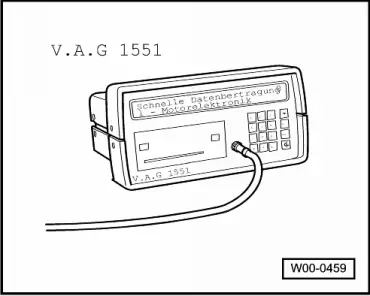| Indicated on the display: |
| –
| Press keys 0 and 6 for the “End output” function and confirm input with the Q key. |
| –
| Eliminate the faults printed out using the fault table → Chapter |
| During test and assembly work, faults can be recognised from other control units like e.g. plugs disconnected. Accordingly, once work is completed, fault memories of all control units must be interrogated and erased. To do this: |
| –
| Press key 0 twice for address code “Automatic test sequence” and confirm entry with the Q key. The -V.A.G 1551- will transmit all known address codes one after the other. |
| If the control unit answers with its identification, the number of faults found or the message “no fault recognised” will appear on the display. |
| Any system faults that are stored will be displayed and printed out one after the other. The -V.A.G 1551- will then transmit the next address code. |
|
|
Rapid data transfer HELP | Select function XX |
|

 Note!
Note! Note!
Note!
 Note!
Note! Note!
Note!